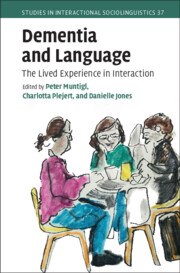Book contents
- Dementia and Language
- Studies in Interactional Sociolinguistics
- Dementia and Language
- Copyright page
- Contents
- Figures
- Tables
- Contributors
- Transcript notation key
- Part 1 Introduction
- Part 2 Dementia and Diagnostics
- Part 3 Dementia and Conversational Strategies
- Part 4 Dementia and Epistemics
- Part 5 Communicative Challenges in Everyday Social Life
- 12 Language and Cognition in Conversations with a Person with Alzheimer’s Disease
- 13 Using Digital Communication Support in Interaction Involving People with Dementia
- 14 “It’s More than Eating, It’s a Social Situation”
- 15 Social Quizzes for People Living with Dementia
- Index
- References
15 - Social Quizzes for People Living with Dementia
How Enactment Impacts Interaction
from Part 5 - Communicative Challenges in Everyday Social Life
Published online by Cambridge University Press: 21 November 2024
- Dementia and Language
- Studies in Interactional Sociolinguistics
- Dementia and Language
- Copyright page
- Contents
- Figures
- Tables
- Contributors
- Transcript notation key
- Part 1 Introduction
- Part 2 Dementia and Diagnostics
- Part 3 Dementia and Conversational Strategies
- Part 4 Dementia and Epistemics
- Part 5 Communicative Challenges in Everyday Social Life
- 12 Language and Cognition in Conversations with a Person with Alzheimer’s Disease
- 13 Using Digital Communication Support in Interaction Involving People with Dementia
- 14 “It’s More than Eating, It’s a Social Situation”
- 15 Social Quizzes for People Living with Dementia
- Index
- References
Summary
This chapter uses conversation analysis to investigate how different quiz formats facilitate or impede participation in group quizzes for people living with dementia. Quizzes are an important way to prompt social interaction and engage people living with dementia. However, their reliance on memory and cognition can present difficulties for staff and players alike. Despite quizzes being based on a question–answer format, the way they are enacted can vary in the following ways: question formulation and type; the type of appropriate answer (i.e., is there one, or more than one, possible correct answer?); the social structure of the quiz (Is the quiz played in teams or individually? Do players self-select to answer or do so in a mediated turn allocation format?); the way the players are spatially organised. All these variations impact the degree to which players can engage with the activity and with one another. Through the examination of different types of quiz format, this chapter outlines and make recommendations for quiz structures which facilitate high participation and uptake, and low threats to face. Data are taken from a corpus of ten quizzes recorded in four different group settings in England.
- Type
- Chapter
- Information
- Dementia and LanguageThe Lived Experience in Interaction, pp. 336 - 355Publisher: Cambridge University PressPrint publication year: 2024

